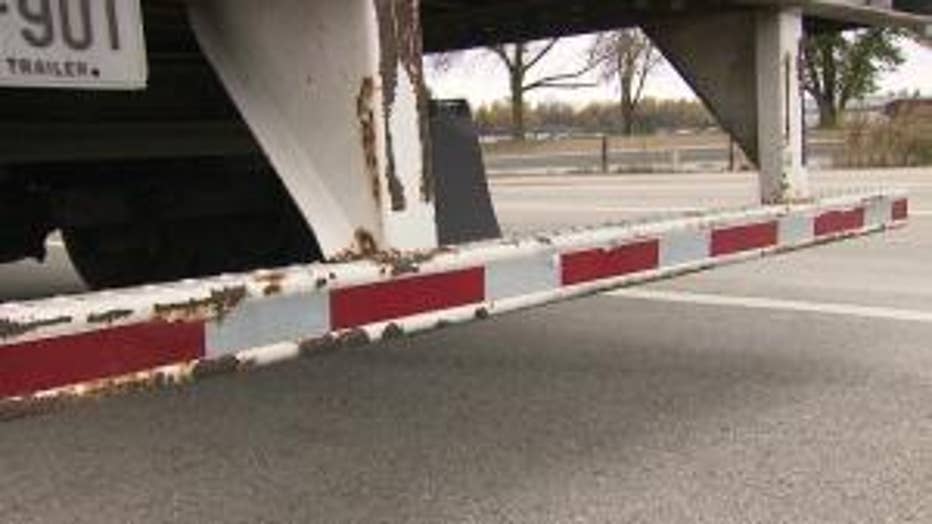Metal bars on back of trucks not keeping drivers safe
Metal bars on back of trucks not keeping drivers safe
Metal bars on back of trucks not keeping drivers safe
BIG BEND (WITI) -- The bars on the backs of semi-truck trailers are supposed to keep cars from sliding underneath a truck during an accident. But a FOX6 investigation reveals they often aren't strong enough to keep drivers safe.
It's a lesson Brenda Jones learned the hard way. Twenty-three years ago she was nine months pregnant with a little boy. Just days before she went into labor, the father of her child died in a car accident.
His car ran into the back of a truck.

"I raised him as a single parent for half of his life and every day kept saying 'just let me get him, let me be okay and keep me here until he's grown,'" she remembers.
After high school, that little boy, named Dustin, enrolled at Purdue University. He played on the varsity bowling team. This spring he came home from college to visit.
"I never thought he'd be gone, too," Jones said.
On the way to see his grandparents, Dustin was killed in a motorcycle accident on his mother's birthday.
Two months passed -- July, 2013 -- Brenda says she had just stopped crying when the phone rang.
"It was someone from my husband's work, asking if my husband was here. They've been trying to reach him. They couldn't reach him," she said.
She remembers hearing about a crash on the news -- and she says, she just knew.
"I just, I ran to the scene," recalled Jones.
Her husband, 37-year-old Ben Jones was trapped underneath a semi-truck on I-894.

Cameras caught the accident on tape. The semi he hit was moving at a snail's pace. Other drivers were able to swerve around the truck. Jones wasn't as lucky.
His pickup truck slid underneath the trailer and he was trapped, unconscious. Police pronounced him dead at the scene.
"We just couldn't keep him long enough to survive the crash," said Greenfield Firefighter Jeff Hohensee.
Witnesses said a special safety bar on the back of the trailer had failed, which is how Jones' pickup truck got lodged underneath.
"I asked and was told that the bar had broken off," Jones remembers.
That bar is called an underride guard, and while chances are you probably haven't noticed them before, most semi-trailers are required to have them. They hang down off the backs of trailers and they're supposed to keep cars from sliding underneath during an accident.
But time and time again research shows they don't work, and hundreds of drivers each year die violent, preventable deaths.
"They couldn't get to him because he ended up underneath the truck," said Jones.
No one routinely keeps track of how many people die this way. But in 2011, the last time anyone counted, 260 people died in rear-end underride crashes. Two were from Wisconsin.

Wisconsin State Patrol inspectors say there's really no way for drivers on the road to tell if a bumper is safe. Most are required to be no more than 22 inches above the ground and they have to have reflectors.
State Patrol Inspector Mark Barlar says rust is only a concern if it goes through. He checks trucks for cracks and missing bolts -- but says he rarely has to ticket drivers for faulty bumpers.
He admits even the closest inspection might not be enough to keep drivers safe. That's because there's no way to test an underride guard to see if it really will hold up in a bad accident.
"There is no way for me to test structural integrity of it. If you could move it by hand that would be a bad thing," Barlar said.
Even if the bumper meets all the legal requirements -- you could still be in danger.

Matt Brumbelow is a senior research engineer for the Insurance Institute for Highway Safety. This spring he and his colleagues released a study. It concluded the current safety standards are "not good enough."
"Roughly 3-5 years ago when we started seeing some of the crash data that made us wonder if something else could be done," Brumbelow said.
According to his findings, federal laws regulating semi-truck bumpers aren't cutting it. They conducted crash tests as speeds as low as 35 miles per hour. The results were deadly.
"The guard just breaks off the trailer," Brumbelow said.
That's why Canadian underride guards are required to be twice as strong as the ones traveling on U.S. highways.
Since 2011 the IIHS has been petitioning the federal government to make the same change in the United States -- to make drivers on our roads safer. But so far nothing has been done. Read the petition here: petition_2011-02-28
Some trailer manufacturers are now taking things into their own hands. They are voluntarily making bumpers stronger.
"You want to put the safest vehicles you can on the road," said Mark Matthiae, president of a company called Crystal Finishing headquartered in Wausau, WI.
After seeing videos of the deadly crash tests, his company decided it wanted their trucks to have the strongest bumpers on the market, so they partnered with a Canadian company called Manac. In crash tests, Manac's guards did their job. They kept drivers from sliding underneath the truck.
"I just don't understand why the manufacturers wouldn't want to make that change. It looks to me like very little cost difference. In fact, it could almost be a cost savings if it's designed properly," Matthiae said.
It makes sense to Brenda Jones, too.

"If it means that maybe somebody can help someone else -- it's too late for us," she said - a single mother for the second time.
"You hear this little voice standing next to you say 'I can't go to the father-daughter dance anymore' or 'a little boy is having a meltdown because his dad had promised him fireworks on his first day of kindergarten, and dad's not here,'" she laments.
"He should be here. There's no reason. They both should be here," Jones said.

